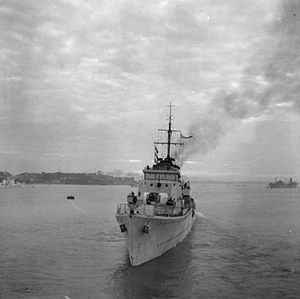Construction and design
Atherstone was ordered from Cammell Laird of Birkenhead on 21 March 1939, as one of the first batch of ten Hunt-class destroyers. [2] The Hunts were intended to make up for a shortage in destroyer-type vessels, particularly for escort duties. They were to combine the heavy anti-aircraft armament of the Bittern-class sloops (i.e. six 4 inch (102 mm) QF Mk XVI dual purpose (anti-ship and anti-aircraft) guns in three twin mounts) with a speed of 29 knots (54 km/h; 33 mph) (compared with 18+3⁄4 knots (35 km/h; 22 mph) for the Bitterns) to allow them to work with the fleet when necessary. [3] [4] This was supplemented by a close-in anti-aircraft armament of a quadruple 2-pounder "pom-pom", and an anti-submarine armament of 30 depth charges. No torpedo-tubes were to be carried. [5]
Atherstone was laid down on 8 June 1939 and launched on 12 December 1939. [2] An inclining test when the ship was fitting out showed that she, and by extension all the Hunts, was dangerously unstable owing to a design error. [lower-alpha 1] To restore stability to acceptable levels, one twin 4 inch mount was removed, the ship's superstructure and funnel was cut down and additional ballast was fitted. [7] Thus modified, Atherstone was completed and commissioned (with the pennant number L05 [8] ) on 23 March 1940. [2]
Atherstone was 264 feet 3 inches (80.54 m) long between perpendiculars and 280 feet (85.34 m) overall. The ship's beam was 29 feet 0 inches (8.84 m) and draught 7 feet 9 inches (2.36 m). As modified, displacement was 1,000 long tons (1,000 t ) standard and 1,360 long tons (1,380 t) under full load. Two Admiralty boilers raising steam at 300 pounds per square inch (2,100 kPa) and 620 °F (327 °C) fed Parsons single-reduction geared steam turbines that drove two propeller shafts, generating 19,000 shaft horsepower (14,000 kW) at 380 rpm. This gave a speed of 27.5 knots (50.9 km/h; 31.6 mph). [1]
The ship's main gun armament was four 4 inch (102 mm) QF Mk XVI dual purpose (anti-ship and anti-aircraft) guns in two twin mounts, with one mount forward and one aft. Additional close-in anti-aircraft armament was provided by a quadruple 2-pounder "pom-pom" mount. [9] [1] The ship was later modified by adding two single Oerlikon 20 mm cannon on the bridge wings, while a single "pom-pom" was mounted in the ship's bow. [10] Up to 40 depth charges could be carried. [1] [11] The ship had a complement of 146 officers and men. [1]
Service
Following commissioning and initial trials, Atherstone joined the First Destroyer Flotilla based at Portsmouth employed on convoy escort duties in the English Channel. [12] In June and July, she was detached to the Home Fleet, returning to Portsmouth in August. [13] On 11 September 1940, while escorting Convoy CW11 in the Channel, Atherstone was hit by two bombs and near missed by a third, sustaining serious damage and killing 5 men. [12] [13] [14] After repair at Chatham Dockyard, the ship rejoined the First Destroyer Flotilla in January 1941, resuming convoy escort duty in the Channel. In December 1941, after a refit at Southampton, Atherstone transferred to the 15th Destroyer Flotilla based at Devonport. [12] [13]
On 26 March 1942 Atherstone sailed from Falmouth as part of Operation Chariot, the St Nazaire Raid. This was an amphibious assault on the port of St Nazaire in France with the objective of destroying the gates of the Normandie dock by ramming them with an explosive-packed destroyer, Campbeltown, and so prevent the dock's use by the German battleship Tirpitz. Atherstone and her sister ship Tynedale escorted Campbeltown and the remainder of the strike force, towing the Motor Gun Boat MGB 314 on the passage to St Nazaire. [15] Early on 27 March, Tynedale sighted the German submarine U-593, and the two escort destroyers attacked the U-boat. Although U-593 survived the attack, the destroyers forced the U-Boat to stay submerged for several hours, preventing it from interfering with the operation. [16]
In May 1942 Atherstone transferred to the 16th Destroyer Flotilla, escorting convoys off the East coast of Britain. [12] In March 1943 the ship transferred to the Mediterranean, joining the 18th Destroyer Flotilla. [13] In July 1943, Atherstone took part in the Allied invasion of Sicily, forming part of the naval force supporting the landing of the British XXX Corps south-west of Syracuse. [13] [17] In September 1943, Atherstone took part in Operation Avalanche, the Anglo-American landings at Salerno in Italy, forming part of the escort for the force of aircraft carriers providing air cover for the landings. [18] [19]
On 26 November 1943 she rescued about 70 survivors from the troopship HMT Rohna, which had been sunk by a Henschel Hs 293 glide bomb off the coast of French Algeria. [20] In August 1944, the Allies invaded the South of France, with Atherstone escorting convoys to the beaches. [21] [22]
In November 1944, Atherstone joined the 5th Destroyer Flotilla based at Alexandria, [23] which was deployed in the Adriatic Sea. On 9 December Atherstone and the destroyer Aldenham shelled German troops on the island of Rab. [24] On 14 December 1944, the two destroyers carried out another bombardment operation against targets on Pag. On returning from this operation, Aldenham struck a mine and sank 45 nmi (52 mi; 83 km) SE of Pola. Atherstone picked up 63 survivors, but 126 were killed. [12] [25] [24]
On 23 September 1945 Atherstone sailed from the Mediterranean for Britain and was paid off into the reserve at Portsmouth. In 1953 she was transferred to Cardiff, remaining in extended reserve. On 23 November 1957, Atherstone was transferred to the British Iron & Steel Corporation for disposal, and was towed to Port Glasgow for scrapping by Smith & Houston. [23] [26]

The first HMS Montrose was one of eight Admiralty-type destroyer leaders, sometimes known as the Scott class. They were named after figures from Scottish history; Montrose was named for the Graham Dukes of Montrose. She was built during the First World War, but was completed too late for service then. However, she had a long career in the inter-war years and saw extensive service during the Second World War.

HMS Jaguar was a J-class destroyer of the Royal Navy. Commissioned in September 1939, she was present at the Dunkirk evacuation the following year, during which Jaguar was damaged by dive bombers. She later served in the Mediterranean and was involved in several actions there. She was torpedoed off the coast of Egypt on 26 March 1942 and sunk.
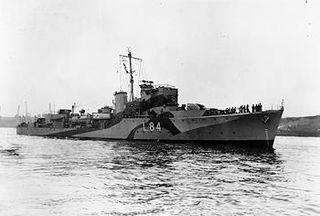
HMS Hursley was a Second World War Type II Hunt-class escort destroyer of the British Royal Navy. She is the only Royal Navy ship to have carried this name. Hursley is a village in Hampshire. Commissioned in 1942, she served in the Mediterranean, before being transferred to the Hellenic Navy in November 1943 and renamed Kriti. She took part in the landings in Sicily, Anzio, and southern France, and remained in Greek service until 1959.
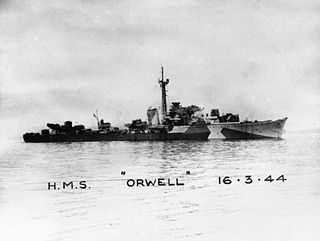
HMS Orwell was an O-class destroyer of the Royal Navy that entered service in 1942 and was broken up in 1965.
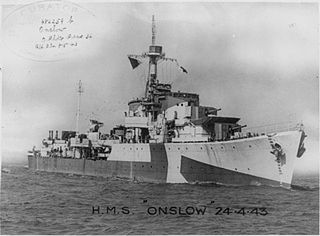
HMS Onslow was an O-class destroyer of the Royal Navy. The O-class were intermediate destroyers, designed before the outbreak of the Second World War to meet likely demands for large number of destroyers. They had a main gun armament of four 4.7 in guns, and had a design speed of 36 kn. Onslow was ordered on 2 October 1939 and was built by John Brown & Company at their Clydebank, Glasgow shipyard, launching on 31 March 1941 and completing on 8 October 1941.

HMS Paladin was a P-class destroyer of the Royal Navy that served in the Second World War. She was built by John Brown and Co. Ltd., Clydebank. She saw action in the Mediterranean and Far East. After the war she was converted into a type 16 frigate and was eventually scrapped in 1962.

HMS Beaufort was a Hunt-class destroyer of the Royal Navy. She was laid down on 17 July 1940 at Cammell Laird, Birkenhead. She was launched on 9 June 1941 and commissioned on 3 November 1941. During the Second World War the ship served in the Mediterranean Sea, escorting convoys and covering landings. She was transferred to the Royal Norwegian Navy in 1952 and scrapped in 1965.

HMS Wrestler (D35) was a V and W-class destroyer built by the Royal Navy during the First World War and active from 1939 to 1944 during the Second World War. She was the first Royal Navy ship to bear that name, and the only one to do so to date.

HMS Westcott (D47) was a Royal Navy Admiralty W-class destroyer that served in the Second World War. In the Second World War Westcott served in an anti-submarine role and escorted numerous Atlantic and Malta convoys.

HMS Zetland was a Royal Navy Type II Hunt-class destroyer, named after the Zetland Hunt.

HMS Chiddingfold (L31) was a Type II Hunt-class destroyer of the Royal Navy. She was leased to the Indian Navy in 1952 where she served as INS Ganga (D94).
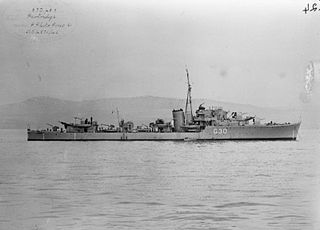
HMS Partridge was a P-class destroyer of the Royal Navy. The O-class were intermediate destroyers, designed before the outbreak of the Second World War to meet likely demands for large number of destroyers. They had a main gun armament of four 4.7 in guns, and had a design speed of 36 kn. Partridge was built by Fairfield Shipbuilding and Engineering Company at their Govan, Scotland shipyard, launching on 5 August 1941 and completing on 22 February 1942.

HMS Albrighton was a Type III Hunt-class destroyer built for the British Royal Navy. She entered service in February 1942, first carrying out an attack on German ships in the English Channel then taking part in the Dieppe Raid, rescuing survivors from the sinking destroyer HMS Broke. Albrighton was next assigned to search for and destroy the German auxiliary cruiser Komet, then escorted a convoy to Gibraltar in prevision of the Allied landings in North Africa. Between December 1942 and April 1943, she participated in the sinking of three more Axis ships with the First Destroyer Flotilla. During the Normandy Landings in June 1944, Albrighton served as a headquarters ship, then sank two German trawlers in the weeks after the invasion. After being converted to a destroyer in early 1945, she was damaged in a collision with a Landing Ship, then was assigned to the British Eastern Fleet. However, the war ended before she was deployed and Albrighton went into reserve.

HMS Brocklesby was a Type I Hunt-class destroyer of the Royal Navy. She served during the Second World War, spending much of the time in the English Channel and Mediterranean, taking part in the Dieppe Raid in 1942, and the Allied landings in Sicily and at Salerno in 1943. After the war, she was used as a sonar trials ship until 1963, and was sold for scrap in 1968.

HMS Berkeley was a Type I Hunt-class destroyer of the Royal Navy. She was a member of the first subgroup of the Hunt class and saw service in World War II before being bombed at Dieppe and then scuttled by HMS Albrighton.
HMS Talybont was a Type III Hunt-class escort destroyer which served in the Royal Navy. She was launched in February 1943 and completed in May that year, serving for the rest of the Second World War. She took part in the Normandy Landings in June 1944, supporting the landings at Omaha Beach and the Pointe du Hoc. Post war she served in the Mediterranean before being reduced to reserve at the end of 1947. She was sold for scrap in 1961, with disposal completed by 1962.

HMS Airedale was a Hunt-class destroyer built for use by the British Royal Navy during the Second World War. She entered service in early 1942 as a convoy escort, being assigned to the Mediterranean Fleet in May. Airedale was sunk while escorting a convoy from Alexandria to Malta on 15 June 1942 by Sturzkampfgeschwader 3.
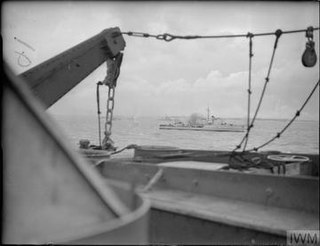
HMS Cottesmore was a Hunt-class destroyer of the British Royal Navy. The ship was built by the Scottish shipbuilder Yarrow at their Scotstoun, Glasgow shipyard in 1939–1940, being launched on 5 September 1940 and commissioning on 29 December that year.

HMS Easton was a Type III Hunt-class destroyer of the British Royal Navy. Easton was built by the shipbuilder J Samuel White in 1941–1942, being launched on 11 July 1942 and completed on 7 December 1942.

HNoMS Eskdale was an escort destroyer of the Type III Hunt class. The destroyer served with the Royal Norwegian Navy. It was sunk by enemy action in 1943.
